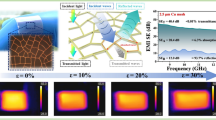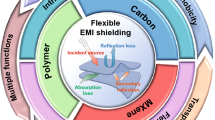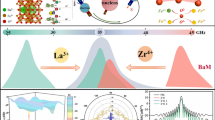Abstract
This paper presents design and analysis of radio frequency microelectromechanical (RF-MEMS) shunt capacitive switch for millimeter wave (mmWave) frequencies. The device performance is tuned at high frequencies to meet the criteria of 5G and beyond, the pillar of all current technology paradigms. The research investigation reveals that independent optimization of electromagnetic and electromechanical performance of switch for specific applications is a major issue. However, the proposed device met all the desired specifications with a novel capacitive shunt topology using separate DC-biasing electrodes and RF signal lines. According to the finite element method (FEM) study the switch has offered on-state losses of 0.2 dB for frequencies below 30 GHz and maximum isolation of 46.3 dB at 24.5 GHz. Electromechanical analysis shows that a low pull-in voltage of 1.9 V and a switching time 107.7 µs are required to switch on and off the transmission of the signal. The simulation results showed the suitability of the RF-MEMS switch for the FR2 band allocated for 5G/B5G applications.










Similar content being viewed by others
Data availability
No new data are created and analyzed in this study.
References
Iannacci J, Tagliapietra G (2022) Getting ready for beyond-5G, super-IoT and 6G at hardware passive components level: a multi-state RF-MEMS monolithic step attenuator analyzed up to 60 GHz. Microsyst Technol. https://doi.org/10.1007/s41870-018-0197-x
Kaur K, Kumar S, Baliyan A (2020) 5G: a new era of wireless communication. Int J Inf Tecnol 12:619–624. https://doi.org/10.1007/s41870-018-0197-x
Dubuc D, Grenier K, Iannacci J (2018) RF-MEMS for smart communication systems and future 5G applications. Smart sensors and MEMS. Elsevier, pp 500–539
Le LB et al (2015) Enabling 5G mobile wireless technologies. EURASIP J Wirel Commun Netw. https://doi.org/10.1186/s13638-015-0452-9
Hong W et al (2021) The role of millimeter-wave technologies in 5G/6G wireless communications. IEEE J Microwav 1(1):101–122
Dahlman E et al (2014) 5G wireless access: requirements and realization. IEEE Commun Mag 52(12):42–47
Osseiran et al (2014) Scenarios for 5G mobile and wireless communications: the vision of the METIS project. IEEE Commun Mag 52(5):26–35
5G; NR; Base Station (BS) Radio Transmission and Reception (Release 16), document 3GPP TS 38.104 version 16.4.0 Release 16, 2020.
Dey S, Koul SK (2021) Reliable, compact, and tunable MEMS bandpass filter using arrays of series and shunt bridges for 28-GHz 5G applications. IEEE Trans Microw Theory Tech 69(1):75–88
Iannacci J (2020) RF-MEMS for 5G applications: a reconfigurable 8-bit power attenuator working up to 110 GHz. Part 1—design concept, technology and working principles. Microsyst Technol 26:675–687. https://doi.org/10.1007/s00542-019-04591-0
Tkachenko V, Lysenko IE, Kovalev AV, Vertyanov DV (2021) High-performance inline RF MEMS switch for application in 5G mobile networks. J Phys 2086:1–6
Sravani KG et al (2020) Design and performance analysis of double cantilever type capacitive shunt RF MEMS switch. Microsyst Technol 26:345–352
Iannacci J et al (2020) RF-MEMS monolithic K and Ka band multi-state phase shifters as building blocks for 5G and Internet of Things (IoT) applications. Sensors MDPI 20(2612):1–13
Iannacci J (2020) RF-MEMS for 5G applications: a reconfigurable 8-bit power attenuator working up to 110 GHz. Part 2—Experimental characterisation of the RF behaviour. Microsyst Technol 26:689–700. https://doi.org/10.1007/s00542-019-04604-y
Tagliapietra G, Iannacci J (2021) A Comprehensive overview of recent developments in RF-MEMS technology-Based high-performance passive components for aplications in the 5G and future telecommunications scenarios. FACTA Univ Ser 34(3):333–366
Nakirekanti M, Hemalatha Y (2022) Embedded and RF switchable ultra-wide band filter bank architecture for radar applications. Int J Inf Technol 14:3155–3163. https://doi.org/10.1007/s41870-022-01061-1
Sun Z, Bian W, Zhao J (2022) A zero static power consumption bi-stable RF MEMS switch based on inertial generated timing sequence method. Microsyst Technol. https://doi.org/10.1007/s00542-021-05248-7
Bhattacharjee A, Dwari S (2021) A monopole antenna with reconfigurable circular polarization and pattern tilting ability in two switchable wide frequency bands. IEEE Antennas Wirel Propag Lett 20(9):1661–1665
Zada M, Ali I, Yoo H (2021) Integration of Sub-6-GHz and mm-wave bands with a large frequency ratio for future 5G MIMO applications. IEEE Access 9:11241–11251
Mirzajani H et al (2017) Power efficient, low loss and ultra-high isolation RF MEMS switch dedicated for antenna switch applications. Microelectronics J 69:64–72. https://doi.org/10.1016/j.mejo.2017.09.004
Khan F, Younis MI (2022) RF MEMS electrostatically actuated tunable capacitors and their applications : a review. J Micromech Microeng 32:1–19. https://doi.org/10.1088/1361-6439/ac3cd5
Peroulis D, Pacheco SP, Katehi LPB (2004) RF MEMS switches with enhanced power-handling capabilities. IEEE Trans Microw Theory Tech 52(1):59–68. https://doi.org/10.1109/TMTT.2003.821234
Kurmendra, Kumar R (2017) Design analysis, modeling and simulation of novel rectangular cantilever beam for MEMS sensors and energy harvesting applications. Int J Inf Technol 9:295–302. https://doi.org/10.1007/s41870-017-0035-6
Tilmans HAC, Raedt WD, Beyne E (2003) MEMS for wireless communications: from RF-MEMS components to RF-MEMS-SiP. J Micromech Micro Eng 13(4):139–163
Rebeiz GM (2004) RF-MEMS theory, design, and technology. John Wiley & Sons
Rebeiz GM, Muldavin JB (2001) RF MEMS switches and switch circuits. IEEE Microw Mag 2(4):59–71. https://doi.org/10.1109/6668.969936
Kumari R, Angira M (2020) Impact of power handling capability on material selection of RF-MEMS switches using MCDM techniques. IEEE Int Symp Smart Electron Syst. https://doi.org/10.1109/iSES50453.2020.00066
Kumari R, Angira M (2022) Analysis on maximizing the performance of RF-MEMS switches across multiple domains through appropriate bridge material selection. Microsyst Technol. https://doi.org/10.1007/s00542-022-05277-w
Kumari R, Angira M (2022) FEM simulation and material selection for enhancing the performance of a RF-MEMS capacitive switch. J Comput Electron. https://doi.org/10.1007/s10825-022-01905-w
Persano F, Quaranta A, Taurino P, Siciliano A, Iannacci J (2020) Thin film encapsulation for RF MEMS in 5G and modern telecommunication systems. Sensors 20(2311):1–12. https://doi.org/10.3390/s20072133
Iannacci J (2018) Internet of things (IoT); internet of everything (IoE); tactile internet; 5G – a (not so evanescent) unifying vision empowered by EH-MEMS (energy harvesting MEMS) and RF-MEMS (radio frequency MEMS). Sens Actuators A 272:187–198. https://doi.org/10.1016/j.sna.2018.01.038
Sharan P, Sandhya KV, Barya R et al (2021) Design and analysis of MOEMS based displacement sensor for detection of muscle activity in human body. Int J Inf Technol 13:397–402. https://doi.org/10.1007/s41870-020-00533-6
Angira M (2023) Accurate dynamic response expressions for electrostatically actuated RF-MEMS switches with damping effect. Int J Inf Technol 15:2133–2137. https://doi.org/10.1007/s41870-023-01276-w
Bartolucci G et al (2008) An equivalent-circuit model for shunt-connected coplanar microelectromechanical system switches for high frequency applications. J Appl Phys. https://doi.org/10.1063/1.3003568
Kumari R, Angira M (2022) Investigation on switching structure geometries and their impact on electromagnetic response of RF-MEMS capacitive switch. Asian Conf Innov Technol (ASIANCON). https://doi.org/10.1109/ASIANCON55314.2022.9909237
Chand G, Maity R, Rao KS, Maity NP (2021) Electromagnetic modelling and analysis of RF MEMS capacitive shunt switch for 5G applications. Microelectron J 117:105262. https://doi.org/10.1016/j.mejo.2021.105262
Narayana TL, Sravani KG, Rao KS (2017) Design and analysis of CPW based shunt capacitive RF MEMS switch. Cogent Eng. https://doi.org/10.1080/23311916.2017.1363356
Angira M, Bansal D (2020) Realization of a capacitive shunt RF-MEMS switch using straight flexure based non-uniform bridge structure-fabrication and characterization. Microsyst Technol 27:2021–2026. https://doi.org/10.1007/s00542-020-04974-8
Sravani KG, Guha K, Rao KS (2020) Design of a novel step structure RF MEMS switch for K-band applications. Microsyst Technol 27:619–627. https://doi.org/10.1007/s00542-020-04943-1
Angira M, Sundaram GM, Rangra K (2015) A novel approach for low insertion loss, multiband, capacitive shunt RF-MEMS switch. Wirel Pers Commun 83:2289–2301. https://doi.org/10.1007/s11277-015-2521-0
Bansal PK, Kumar A (2021) Improvement of RF MEMS devices by spring constant scaling laws. J Comput Electron 20:1006–1011. https://doi.org/10.1007/s10825-021-01657-z
Rao KS et al (2019) Design, modeling and analysis of perforated RF MEMS capacitive shunt switch. IEEE Access 7:74869–74878. https://doi.org/10.1109/ACCESS.2019.2914260
Angira M, Rangra K (2015) Design and investigation of a low insertion loss, broadband, enhanced self and hold down power RF-MEMS switch. Microsyst Technol 21(6):1173–1178. https://doi.org/10.1007/s00542-014-2188-6
Rao KS, Naveena P, Sravani KG (2019) Materials impact on the performance analysis and optimization of RF MEMS switch for 5G reconfgurable antenna. Trans Electr Electron Mater. https://doi.org/10.1007/s42341-019-00114-w
Kondaveeti GS, Guha K, Karumuri SR, Elsinawi A (2019) Design of a novel structure capacitive RF mems switch to improve performance parameters. IET Circuits Dev Syst 13(7):1093–1101. https://doi.org/10.1049/iet-cds.2019.0206
Mafinejad Y, Ansari HR, Khosroabadi S (2020) Development and optimization of RF MEMS switch. Microsyst Technol 26:1253–1263. https://doi.org/10.1007/s00542-019-04655-1
Verma V, Angira M (2021) A shunt capacitive switch based on RF MEMS technology for 5G application: design and Investigation. Int Conf Intell Technol (CONIT). https://doi.org/10.1109/CONIT51480.2021.9498323
Chand G, Maity R, Rao KS, Maity NP, Sravani KG (2021) Design and analysis of novel RF-MEMS capacitive type shunt switch for 5G applications. Trans Electr Electron Mater. https://doi.org/10.1007/s42341-021-00315-2
Kumar PA, Karumuri SR, Koandavitee GS, Guha K (2022) Design and performance analysis of a low-pull-in-voltage RF MEMS shunt switch for millimeter-wave therapy, IoT, and 5G applications. J Comput Electron. https://doi.org/10.1007/s10825-022-01863
Acknowledgements
Authors would like to give their sincere thanks to CSIR-Central Electronics Engineering Research Institute, Pilani for providing software help to complete this work.
Funding
Funding has not been received from any sources for this work.
Author information
Authors and Affiliations
Corresponding author
Ethics declarations
Conflict of interest
All authors read and approved the final manuscript and have no conflict of interest.
Ethical statement
The research meets all standards regarding the ethics of experimentation and research integrity. There are no concerns about animal or human experimentation.
Rights and permissions
Springer Nature or its licensor (e.g. a society or other partner) holds exclusive rights to this article under a publishing agreement with the author(s) or other rightsholder(s); author self-archiving of the accepted manuscript version of this article is solely governed by the terms of such publishing agreement and applicable law.
About this article
Cite this article
Kumari, R., Angira, M. RF-MEMS capacitive switches: enabling transition towards 5G/B5G applications. Int. j. inf. tecnol. 15, 3889–3897 (2023). https://doi.org/10.1007/s41870-023-01457-7
Received:
Accepted:
Published:
Issue Date:
DOI: https://doi.org/10.1007/s41870-023-01457-7




